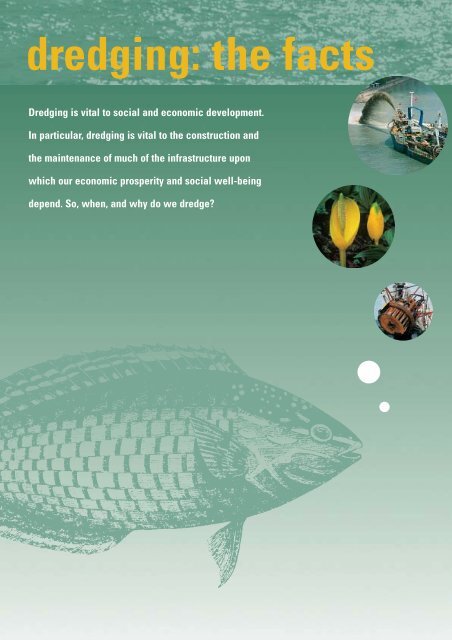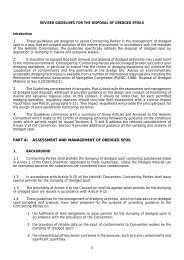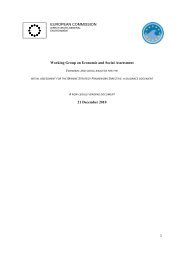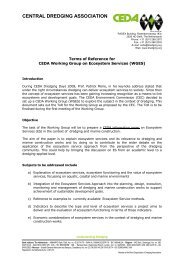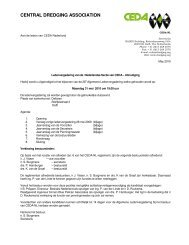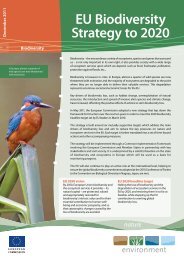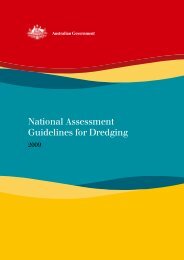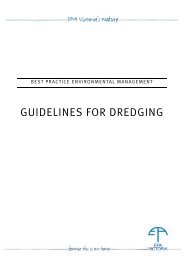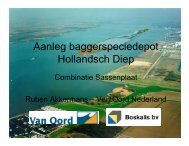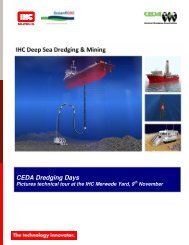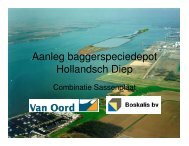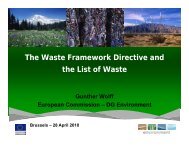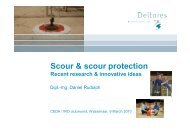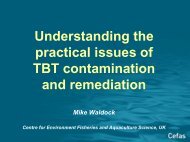dredging: the facts - Central Dredging Association
dredging: the facts - Central Dredging Association
dredging: the facts - Central Dredging Association
Create successful ePaper yourself
Turn your PDF publications into a flip-book with our unique Google optimized e-Paper software.
<strong>dredging</strong>: <strong>the</strong> <strong>facts</strong><strong>Dredging</strong> is vital to social and economic development.In particular, <strong>dredging</strong> is vital to <strong>the</strong> construction and<strong>the</strong> maintenance of much of <strong>the</strong> infrastructure uponwhich our economic prosperity and social well-beingdepend. So, when, and why do we dredge?
WHY WE DREDGE<strong>Dredging</strong> for navigationFrom <strong>the</strong> very beginnings of civilisation, people, equipment,materials and commodities have been transported by water.Ongoing technological developments and <strong>the</strong> need to improvecost effectiveness have resulted in larger, more efficient ships.This, in turn, has resulted in <strong>the</strong> need to enlarge or deepenmany of our rivers and canals, our “aquatic highways”, in orderto provide adequate access to ports and harbours. Nearly all<strong>the</strong> major ports in <strong>the</strong> world have at some time required new<strong>dredging</strong> works – known as capital <strong>dredging</strong> – to enlarge anddeepen access channels, provide turning basins and achieveappropriate water depths along waterside facilities.Beaches in Alicante, Spain, before replenishment (left) and after (right).Beach nourishment is now commonplace in many parts of <strong>the</strong> world and <strong>the</strong>demand for dredged materials from offshore borrow areas has consequentlyincreased significantly in recent years.2Capital <strong>dredging</strong> in Hong Kong wasundertaken for both <strong>the</strong> new airportand new container terminals.Many of <strong>the</strong>se channels have later required maintenance<strong>dredging</strong>, i.e. <strong>the</strong> removal of sediments which have accumulatedin <strong>the</strong> bottom of <strong>the</strong> dredged channel, to ensure that <strong>the</strong>ycontinue to provide adequate dimensions for <strong>the</strong> large vesselsengaged in domestic and international commerce.Waterborne transport is vital to domestic and internationalcommerce. It offers <strong>the</strong> most economical, energy efficient andenvironmentally friendly transportation of all types of cargo.Navigation projects must keep pace with waterborne transportneeds in order to support and maintain local, national andregional economies.<strong>Dredging</strong> for construction, reclamation and mining<strong>Dredging</strong> is an important way of providing sands and gravels forconstruction and reclamation projects. In <strong>the</strong> last two decades,<strong>the</strong> demand, and <strong>the</strong> associated extraction rates, for suchoffshore aggregates have significantly increased.Dredged aggregates have a wide range of uses including:• Land reclamation: pressures arising from population growth andport and infrastructure developments in coastal areas havecreated a need to raise <strong>the</strong> elevation of low-lying areas and/or toconstruct new land areas. Such pressures are likely to continue.• Construction materials: an increasing quantity of marineaggregate is being used in concrete and fill, including fill forreclamation projects.<strong>Dredging</strong> is also often undertaken in order to:• create underwater foundations;• facilitate <strong>the</strong> emplacement of pipelines or immersed tunnelelements;• construct flood control structures such as dams, dikes or levees;• ensure flood defences (by improving or maintaining <strong>the</strong>discharge capacity of watercourses);• create or maintain storage capacity in water supply reservoirs.In addition, though perhaps less commonly, <strong>dredging</strong> may beused to recover minerals and precious metals, or to remove<strong>the</strong> overburden in order to reach <strong>the</strong>se. As with land-basedextraction, <strong>the</strong>re are environmental concerns about marineaggregates extraction. None<strong>the</strong>less, <strong>dredging</strong> can have distincteconomic and environmental advantages in comparison toquarrying.<strong>Dredging</strong> for <strong>the</strong> environment<strong>Dredging</strong> can be undertaken to benefit <strong>the</strong> environment inseveral ways. Dredged materials are frequently used to createor restore habitats. Recent decades have also seen <strong>the</strong> increasinguse of dredged materials for beach replenishment.These schemes are designed to prevent – or reduce <strong>the</strong>likelihood of – erosion or flooding. Such beach nourishmentor recharge is achieved by placing dredged sand or gravel oneroding beaches. This represents a “soft-engineering” solution,an important alternative to – often more costly – structuralsolutions such as rock armour or concrete walls.Ano<strong>the</strong>r environmental use of <strong>dredging</strong> has been in initiativesdesigned to remove contaminated sediments, thus improvingwater quality and restoring <strong>the</strong> health of aquatic ecosystems.This so-called “remediation” or “clean-up” <strong>dredging</strong> is used inwaterways, lakes, ports and harbours in highly industrialised orurbanised areas. The removed material may be treated and usedafterwards, or disposed of under strict environmental controls.Under proper conditions a viable alternative to removal is in-situisolation, i.e. <strong>the</strong> placement of a covering or a cap of cleanmaterial over <strong>the</strong> contaminated deposit.
THE DREDGING PROCESSCapital (or new) <strong>dredging</strong> projects can be both extensive andexpensive. Maintenance <strong>dredging</strong> is often a regular, perhapsannual ongoing, long-term activity. In ei<strong>the</strong>r case, what are <strong>the</strong>key elements of <strong>dredging</strong>? The <strong>dredging</strong> process consists of <strong>the</strong>following three elements:• Excavation: this process involves <strong>the</strong> dislodgement and removalof sediments (soils) and/or rocks from <strong>the</strong> bed of <strong>the</strong> waterbody. A special machine - <strong>the</strong> dredger – is used to excavate <strong>the</strong>material ei<strong>the</strong>r mechanically, hydraulically or by combinedaction. The main types of dredgers are described below.• Transport of excavated material: transporting materials from<strong>the</strong> <strong>dredging</strong> area to <strong>the</strong> site of utilisation, disposal orintermediate treatment, is generally achieved by one of <strong>the</strong>following methods:(a) in self-contained hoppers of <strong>the</strong> dredgers; (b) in barges;(c) pumping through pipelines; and (d) using natural forcessuch as waves and currents.O<strong>the</strong>r, rarely used transport methods are truck and conveyorbelt transport. The method of transport is generally linked to<strong>the</strong> type of dredger being used.• Utilisation or disposal of dredged material: in constructionprojects, <strong>dredging</strong> is driven by <strong>the</strong> demand for dredgedmaterial. In navigation and remediation <strong>dredging</strong>, <strong>the</strong> projectis driven by <strong>the</strong> objective of removing <strong>the</strong> material from itsoriginal place. Thus, <strong>the</strong> question of “what to do with <strong>the</strong>removed material?” arises. As a result of growing environmentalpressure, finding an answer to this question has becomeincreasingly difficult, especially when <strong>the</strong> material iscontaminated. The main alternatives for <strong>the</strong> management of<strong>the</strong> dredged material are described later in this document.Mechanical dredgersThree main sub-groups of mechanical dredger can be identified:• bucket-ladder dredgers;• backhoes; and• grab dredgers.These dredgers are well suited to removing hard-packed materialor debris and to working in confined areas.Mechanical means are used for excavation – dislodging <strong>the</strong>material and <strong>the</strong>n raising it to <strong>the</strong> water surface – in a way similarto dry land excavation methods. Mechanically dredged sedimentsare generally transported by barges. Cohesive sediments dredgedand transported this way usually remain intact, with large piecesretaining <strong>the</strong>ir in-situ density and structure through <strong>the</strong> whole<strong>dredging</strong> and placement process.Hydraulic dredgersThree main sub-groups of hydraulic dredger are:• stationary suction dredgers;• cutter suction dredgers; and• trailing suction hopper dredgers.These dredgers use hydraulic centrifugal pumps to provide <strong>the</strong>dislodging and lifting force and remove <strong>the</strong> material in a liquidslurry form. They usually work well in loose, “unconsolidated”silts, sands, gravels and soft clays. In more cohesive materialsteeth or waterjets may be applied for breaking up <strong>the</strong> material.Cutter suction dredgers are equipped with a cutting device toincrease <strong>the</strong> dislodging force. These “cutter” dredgers aresuitable for use in high strength materials such as clays, packedor compacted sands and rocks.3TYPES OF DREDGERSHow do we dredge? With specialised <strong>dredging</strong> equipment whichvaries widely, coming in many sizes and types, and includingmainly water-based and sometimes land-based machines.<strong>Dredging</strong> equipment, classified according to <strong>the</strong> methods ofexcavation and operation, can be grouped into <strong>the</strong> following maincategories:• mechanical dredgers;• hydraulic dredgers;• special, low-impact dredgers; and• o<strong>the</strong>r types of dredgers.Within <strong>the</strong> above categories fur<strong>the</strong>r subgroups can be identifiedon <strong>the</strong> basis of propulsion, i.e. self-propelled versus stationary.The selection of <strong>dredging</strong> equipment for a particular project willdepend upon a combination of factors, including:• <strong>the</strong> type of physical environment;• <strong>the</strong> nature, quantity and level of contamination of <strong>the</strong> materialto be dredged;• <strong>the</strong> method of placement; and• <strong>the</strong> distance to <strong>the</strong> placement site.Increasingly strict environmental regulations have led tosignificant developments in <strong>dredging</strong> equipment. These includeautomatic control, positioning systems and degassing systems.These innovations aim to reduce potentially adverseenvironmental impacts.Transport methods associatedwith hydraulic dredgers arepipeline and hopper transport.In some cases, hydraulicdredgers may pump <strong>the</strong> materialsinto barges for transport.Hydraulic <strong>dredging</strong> andtransport methods “slurry <strong>the</strong>sediment”, that is, <strong>the</strong>y addlarge amounts of process waterand thus change <strong>the</strong> originalstructure of sediments.Trailing suction hopper dredgers comein a variety of sizes to suit <strong>the</strong> task.Close-up of a cutterhead.
Special low-impact ( "environmental/restoration") dredgersIt is increasingly important to dredge contaminated sediments inan environmentally acceptable manner, in particular ensuringthat contaminants are not re-mobilised and/or released into <strong>the</strong>water column where <strong>the</strong>y may detrimentally affect aquatic life.A new range of equipment has <strong>the</strong>refore been developed with<strong>the</strong> aim of increasing precision, i.e by reducing over<strong>dredging</strong>,and minimising <strong>the</strong> suspension of bed material. In some casesexisting dredger types have been modified; in o<strong>the</strong>r casescompletely new dredgers have been designed. Examples include<strong>the</strong> following: encapsulated bucket lines for bucket chaindredgers; closed buckets for backhoes; closed clamshells for grabdredgers; auger dredger, disc cutter, scoop dredger and sweepdredger (all modified cutter dredgers).O<strong>the</strong>r types of dredgersThere are a number of <strong>dredging</strong> machines which do not readily fitinto <strong>the</strong> above categories. Many of <strong>the</strong>m comprise specialisedtools developed for specific purposes. Of particular note arehydronamic <strong>dredging</strong> techniques that do not raise <strong>the</strong> dredgedmaterial above <strong>the</strong> water surface e.g. water injection dredgers.DREDGED MATERIAL MANAGEMENTALTERNATIVESWhen we dredge, what do we do with <strong>the</strong> dredged material?In <strong>the</strong> last thirty years this has become one of <strong>the</strong> crucial issuesof <strong>dredging</strong> and <strong>the</strong>re has been a continual dialogue amongstmany nations and organisations on <strong>the</strong> subject. With <strong>the</strong> goalof protecting <strong>the</strong> environment and still fur<strong>the</strong>ring economicdevelopment, <strong>the</strong> parties involved have reached some significantagreements.Regulatory aspectsBoth <strong>dredging</strong> and disposal are now carefully regulated.In addition to national and regional legislation and policies, <strong>the</strong>most widely applicable international regulatory instrument is<strong>the</strong> London Convention 1972 (LC-72), which covers <strong>the</strong> marinewaters of <strong>the</strong> whole world. LC-72 adopted <strong>the</strong> Dredged MaterialAssessment Framework (DMAF), a widely reviewed andaccepted approach to <strong>the</strong> assessment of suitability of dredgedmaterial for disposal at sea. The contracting parties to <strong>the</strong>Convention, some 90 countries, are now expected to adopt <strong>the</strong>DMAF accordingly. There are also regional conventions suchas <strong>the</strong> Oslo and Paris Convention, <strong>the</strong> Helsinki Convention and<strong>the</strong> Barcelona Convention.4The encapsulated bucket dredger(above) and <strong>the</strong> auger dredger (left)are two examples of speciallydesigned environmental <strong>dredging</strong>equipment.Legislation controlling placement on land (and in inlandwaters) is based on national regulatory systems often involving agreat variety of laws prepared for various waste materials, e.g.sewage sludge, agricultural and industrial waste. Some countriesare now developing regulations specifically for dredged material.Some <strong>dredging</strong> initiatives, particularly those which compriseregular operations such as annual maintenance <strong>dredging</strong> ofa waterway, may not need to be <strong>the</strong> subject of detailedinvestigations. Most major/new <strong>dredging</strong> or disposal projectsshould, however, have studies carried out in order to ensurethat any potential adverse effects are identified in advance anddealt with in an appropriate manner. Such investigationsinclude, for example, technical investigations of <strong>dredging</strong> anddisposal options, physical process studies and environmentalimpact studies.Management alternatives for dredgedmaterial can be grouped into <strong>the</strong>following five main categories:• Sustainable relocation• Beneficial use• Open-water disposal• Confined disposal• TreatmentArtificial gravel, produced fromcontaminated dredged material,is used in manufacturing concrete.Sustainable relocationMarine or fluvial sediment normaly contributeto <strong>the</strong> sustainabililty of natural ecosystems.Their role in river, estuarine and costal zoneprocesses should be respected wherever possible.In environmental assessment <strong>the</strong>refore as a first option <strong>the</strong> relocationof a estuary in <strong>the</strong> natural environment should be considered.Beneficial useDredged material is increasingly regarded as a resource ra<strong>the</strong>rthan as a waste. More than 90% of sediments from navigation<strong>dredging</strong> comprise unpolluted, natural, undisturbed sediment,
At <strong>the</strong> Black Swamp, a sou<strong>the</strong>rn forested wetland inArkansas, USA, groundwater study measurementsare being taken in winter.which is considered acceptable for a wide range of uses. The DMAFrecognises this and requires that, as a first step in examiningdredged material management options, possible beneficial uses ofdredged material be considered.Beneficial use may be defined as “any use which does not regard <strong>the</strong>material as a waste”. A great variety of options are available, and <strong>the</strong>main types can be distinguished as follows:• coastal protection, e.g. beach nourishment, onshore/offshorefeeding, managed retreat;• agriculture, horticulture, forestry;• habitat development or enhancement, e.g. aquatic habitats,bird habitats, mudflats, wetlands;• amenity development or enhancement, e.g. landscaping;• raising low-lying land;• land reclamation, e.g. for industrial development, housing,infrastructure;• production of construction material, e.g. bricks, clay, aggregates;• construction works, e.g. foundation fill, dikes.Operational feasibility, that is, <strong>the</strong> availability of suitable material in<strong>the</strong> required amount at a particular time, is a crucial aspect ofmany beneficial uses.Open-water disposalOpen-water disposal means that dredged material is placed atdesignated sites in oceans, estuaries, rivers and lakes such that itis not isolated from <strong>the</strong> adjacent waters during placement.Placement is generally via release from pipelines, barges or hoppers.Open-water sites can be ei<strong>the</strong>r dispersive or non-dispersive(retentive) depending on whe<strong>the</strong>r <strong>the</strong> sediment is transportedout of <strong>the</strong> site or remains within <strong>the</strong> designated boundaries.Generally, clean or mildly contaminated sediments are disposed ofin open-water, although <strong>the</strong> disposal of highly contaminated materialcan also be considered with appropriate control measures.Variants of open-water disposal include:• unrestricted placement on waterbeds in <strong>the</strong> form of mounds;• placement with lateral containment in natural or man-madedepressions;• placement with lateral containment behind constructed berms.A cap of clean material over <strong>the</strong> dredged material can provideisolation from <strong>the</strong> benthic environment. If capping is appliedover <strong>the</strong> mound formed by unrestricted placement, it is calledlevel-bottom capping (LBC). If <strong>the</strong> capping is applied with lateralcontainment, it is called contained aquatic disposal (CAD).The majority of <strong>the</strong> stored dredged materialat <strong>the</strong> IJsseloog confined disposal facility inLake Ketelmeer, The Ne<strong>the</strong>rlands, comesfrom <strong>the</strong> clean-up of <strong>the</strong> lake.Confined disposalConfined disposal means that <strong>the</strong> dredged material is placedin an engineered containment structure, that is, within dikesor bunds, or in natural or constructed pits, or borrow pits.This isolates <strong>the</strong> material from surrounding waters or soilsduring and after placement. O<strong>the</strong>r terms used in <strong>the</strong> literaturefor this type of placement include “confined disposal facility"(CDF), “diked disposal site” and “containment area”.CDFs may be constructed in open waters (known as islandCDFs), at near-shore sites or on land.The function of CDFs is to retain <strong>the</strong> dredged material solidswhilst releasing <strong>the</strong> carrier water. For facilities receivingcontaminated material, an additional objective is to provide <strong>the</strong>efficient isolation of contaminants from <strong>the</strong> surrounding area.To achieve this, depending on <strong>the</strong> degree of intended isolation,CDFs may be equipped with a complex system of controlmeasures such as surface covers and liners, treatment ofeffluent, surface runoff and leachate.5
This separation and dewatering plant consistsof several hydrocyclones, which solidifydredged material, thus reducing its quantity.TreatmentTreatment is defined as <strong>the</strong> processing of contaminated dredgedmaterial to reduce its quantity or to reduce <strong>the</strong> contamination.Treatment methods range from separation techniques, in whichcontaminated mud is separated from relatively clean sand,to incineration. Some techniques are well developed but o<strong>the</strong>rsare still in <strong>the</strong> early stages of development. The problem is scale:treatment is often expensive, so <strong>the</strong> treatment of small volumes ofcontaminated material is more likely than that of large volumes.6 ENVIRONMENTAL ISSUESWhat about <strong>the</strong> environment? Is <strong>dredging</strong> good or bad? How dowe find out? <strong>Dredging</strong> plays a vital role in <strong>the</strong> socio-economicdevelopment and <strong>the</strong> environmental health of many countriesand regions in <strong>the</strong> world. Yet any infrastructure or developmentproject can have impacts on <strong>the</strong> environment, and <strong>dredging</strong> is noexception.Welded sheets of PEHD plasticare laid as a basic seal to preventdispersion of contaminants,at <strong>the</strong> Francop land-based CDFin Hamburg, Germany.Effects of <strong>the</strong> <strong>dredging</strong> processDirect or indirect environmental and socio-economic effectsmay be associated with any element of <strong>the</strong> <strong>dredging</strong> process –excavation, transport and disposal. The effects may be positiveor negative, short term or long term and may include, amongsto<strong>the</strong>rs, impacts on:A monitoring well is used to testgroundwater quality, in <strong>the</strong> vicinityof <strong>the</strong> Francop site.• water quality, e.g. increase of suspended solids concentrationand potential release of contaminants during <strong>dredging</strong> ordisposal; leaching of contaminants from disposal sites;• habitats and natural areas, e.g. habitat enhancement orcreation, removal or destruction of benthos, smo<strong>the</strong>ring;• local communities, e.g. <strong>the</strong> effects of noise; increased labouropportunities;• changes to bathymetry or topography;• physical processes, e.g. waves, currents, or drainage,and hence erosion or deposition;• archaeological assets, e.g. shipwrecks;• recreation, e.g. sailing, swimming and beach use;• economic activities, e.g. commercial fishing;improved infrastructure.
Prior to undertaking <strong>dredging</strong> and/or disposal projects, a carefulassessment to identify potential effects and to determine <strong>the</strong>irsignificance is necessary. The “environmental impact assessment”(EIA) should highlight both positive and negative, short- andlong-term impacts.Where potentially significant adverse effects are anticipated,management techniques should be implemented, where possible,to reduce concerns; <strong>the</strong>reafter identification and implementationof practical, cost-effective compensation or mitigation measureswill be required for any residual effects. With managementpractices and effective mitigation, impacts which might o<strong>the</strong>rwisethreaten <strong>the</strong> viability of a particular scheme or initiative canoften be reduced to an acceptable level, or avoided altoge<strong>the</strong>r.As part of <strong>the</strong> ongoing environmental assessment process,<strong>the</strong> subsequent monitoring of environmental parameters may alsobe needed in order to:• measure <strong>the</strong> magnitude of particular changes;• compare such changes to those predicted; and• identify whe<strong>the</strong>r, when or where remedial actions are required.The involvement of interested groups and organisations, consultingwith <strong>the</strong>m and reaching a consensus forms an important componentin <strong>the</strong> process of identifying potential impacts and implementingacceptable mitigation measures. It is in <strong>the</strong> best interests of allparties that <strong>the</strong> need for <strong>the</strong> <strong>dredging</strong> is explained, that <strong>the</strong>decision-making process is transparent, and that <strong>the</strong> reasons for<strong>the</strong> selection of <strong>the</strong> preferred <strong>dredging</strong> and/or disposal option(s)are clearly understood.During <strong>dredging</strong> for <strong>the</strong> ØresundLink between Denmark andSweden, scuba divers takesamples of eelgrass every o<strong>the</strong>rweek to assess impacts.Source control<strong>Dredging</strong> organisations and <strong>the</strong>ir clients – ports and harbours forinstance – can do <strong>the</strong>ir utmost to minimise and monitor <strong>the</strong>impacts of <strong>the</strong> <strong>dredging</strong> activity itself. But what do we do when<strong>the</strong> continuing input of contaminants to a water body, by a factoryor chemical plant for example, presents an ongoing problem inrespect of disposing of contaminated dredged material?Pollution needs to be curtailed at <strong>the</strong> source. Source controlrepresents a potential long-term solution. Indeed, in somecases, it can be argued that source control should have a higherpriority in terms of environmental effectiveness than disposalor treatment of <strong>the</strong> contaminated sediment.The organisation responsible for <strong>dredging</strong> is rarely responsible for<strong>the</strong> pollution, that is, for <strong>the</strong> discharge of <strong>the</strong> contaminants.Achieving source control usually involves substantial collaborationand co-operation between a number of organisations andagencies. These groups must be willing to identify <strong>the</strong> source andtake measures to reduce or prevent fur<strong>the</strong>r pollution. This is noeasy task but it is <strong>the</strong> only viable way to guarantee a long-termsuccessful outcome.From Sewer To FisheryAs early as 1950 <strong>the</strong> countries bordering <strong>the</strong> Rhine had joined toge<strong>the</strong>rand set up <strong>the</strong> International Rhine Commission (ICPR). In 1987, <strong>the</strong> ICPRpresented <strong>the</strong> Rhine Action Programme (RAP) and <strong>the</strong> governments of <strong>the</strong>Rhine bordering countries and <strong>the</strong> EC Commission supported it unanimously.RAP‘s aims included halving <strong>the</strong> number of discharges into <strong>the</strong> river by <strong>the</strong>year 2000. In terms of ecology this was meant to ensure <strong>the</strong> return of higherspecies, such as salmon into <strong>the</strong> river. Emissions of some substances– including a number of heavy metals, organic micropollutants and oil –were to be cut by as much as 90% for <strong>the</strong> year 2000. Thanks to closecooperation between all <strong>the</strong> countries involved, <strong>the</strong> Rhine water todayis considerably less toxic than it was only a few years ago.7Scientists visit a study site at arestored wet prairie in Missouri,USA.
FINDING FURTHERINFORMATION ONDREDGINGResponsible <strong>dredging</strong> and disposalpractices are in everybody’s interest.The following organisations are activelyinvolved in promoting responsible<strong>dredging</strong> and disposal practices.Each of <strong>the</strong>se organisations is able toprovide fur<strong>the</strong>r information to help youunderstand <strong>the</strong> processes and <strong>the</strong> <strong>facts</strong>about <strong>dredging</strong> and disposal. If youhave any questions about <strong>dredging</strong> ordisposal, we encourage you to contactone or all of <strong>the</strong>m.<strong>dredging</strong> or disposal,we encourage you to contact one or allof <strong>the</strong>m.IADC – International <strong>Association</strong> of<strong>Dredging</strong> CompaniesMission: To inform <strong>the</strong> world about<strong>the</strong> fundamental need for <strong>dredging</strong>and <strong>the</strong> beneficial economic, socialand environmental effects of <strong>dredging</strong>.To promote fair practice conditionsand fair competition within <strong>the</strong><strong>dredging</strong> industry and to improve<strong>the</strong> international business climate for<strong>the</strong> private <strong>dredging</strong> industry.Contact: IADC Secretariat,PO Box 80521, 2508 GM The Hague,The Ne<strong>the</strong>rlands. Phone: +31 70 352 3334Fax: +31 70 351 2654E-mail: info@iadc-<strong>dredging</strong>.comwww.iadc-<strong>dredging</strong>.comIAPH – International <strong>Association</strong> ofPorts and HarborsMission: One of IAPH’s missions isto promote <strong>the</strong> development of <strong>the</strong>international port industry, by interalia, helping to define internationalregulations, standards and guidelinescovering <strong>the</strong> environment, including<strong>dredging</strong>.Contact: IAPH Head Office,7th Floor, South Tower, New PierTakeshiba, 1-16-1 Kaigan, Minato-ku,Tokyo 105-0022, Japan.Phone: +81 3 5403 2770Fax: +81 3 5403 7651E-mail: info@iaphworldports.orgwww.iaphworldports.orgPIANC – International Navigation<strong>Association</strong>Mission: PIANC aims to be <strong>the</strong>foremost professional organisation for<strong>the</strong> promotion, managementand sustainable development ofnavigational inland, coastal andocean waterways, embracingports and harbours, logistics,infrastructure and coastal zones,all for <strong>the</strong> safe and efficient operationof all types of commercial andrecreational vessel.Contact: PIANC Secretariat,Graaf de Ferraris Building –11th Floor, Blvd. du Roi Albert II,20 – Box 3, B-1000 Brussels, Belgium.Phone: +32 2 553 71 61Fax: +32 2 553 71 55E-mail: info@pianc-aipcn.orgwww.pianc-aipcn.orgWorld Organization of <strong>Dredging</strong><strong>Association</strong>s (WODA) is composed ofEastern <strong>Dredging</strong> <strong>Association</strong> (EADA),<strong>Central</strong> <strong>Dredging</strong> <strong>Association</strong> (CEDA),and Western <strong>Dredging</strong> <strong>Association</strong>(WEDA). The three associations share<strong>the</strong> mission of WODA:• To promote <strong>the</strong> developmentand exchange of professionalknowledge– scientific, technical,regulatory and managerial – inall fields concerned with <strong>dredging</strong>and handling or placement ofdredged material;• To participate in <strong>the</strong> developmentof international and nationalpolicies, regulations, andguidelines on <strong>dredging</strong> andrelated matters;• To balance <strong>the</strong> environmental,social and economic concernsrelated to <strong>dredging</strong> and dredgedmaterial handling or placementprojects and to encourage opencommunication between allstakeholders;• To enhance contacts betweenindividuals and variousprofessional entities concernedwith <strong>dredging</strong> and associatedmatters and between <strong>the</strong> <strong>dredging</strong>community and <strong>the</strong> society inwhich it works.CEDA, Radex Building,Rotterdamseweg 183c,2629 HD Delft, The Ne<strong>the</strong>rlands,Phone: + 31 (0)15 268 2575Fax: + 31 (0)15 268 2576E-mail: ceda@<strong>dredging</strong>.orgwww.<strong>dredging</strong>.orgEADA Secretariat,c/o Port KlangAuthority, Mail Bag Service 202,42009 Port Klang, Malaysia,Fax: + 603 316 70211E-mail: david@pka.gov.mywww.woda.orgWEDA Executive Offices,P.O. Box 5797, Vancouver,WA 98668-5797 USA.Phone: +1 5360 750 0209Fax: +1 360 750 1445E-mail: weda@comcast.netwww.wesda.western<strong>dredging</strong>.orgPERTINENT LITERATUREBray, RN, AD Bates and JM Land (1997).<strong>Dredging</strong>, a Handbook for Engineers,2nd edition, Arnold Publishing,London, Sydney, Auckland.IADC/CEDA (1996-200),Environmental Aspects of <strong>Dredging</strong>,Guide 1: Players, Processes andPerspectives (1996);Guide 2: Conventions, Codes andConditions (1997);Guide 3: Investigation, Interpretationand Impact (1997);Guide 4: Machines, Methods andMitigation (1998);Guide 5: Reuse, Recycle or Relocate(1999);Guide 6: Effects, Ecology and Economy(1999);Guide 7: Frameworks, Philosophy and<strong>the</strong> Future (2000).IADC/IAPH (2004) <strong>Dredging</strong> forDevelopment 5th edition, RN Bray,Editor.IADC/VBKO/Port of Rotterdam/Rotterdam Public Works Dept. (2001)Construction and Survey Accuraciesfor <strong>the</strong> Execution of <strong>Dredging</strong> andStone Dumping Works.PIANC (1992) Beneficial Uses ofDredged Material: a Practical Guide,Report of PEC Working Group 19.PIANC (1997) Handling andTreatment of Contaminated DredgedMaterial from Ports and InlandWaterways, Report of PEC WorkingGroup 17.PIANC (1997) Dredged MaterialManagement Guide, EnviCom SpecialEdition.PIANC (1999) Management of AquaticDisposal of Dredged Material,EnviCom Working Group 1.PIANC (2000) Glossary ofEnvironmental Terms and Terminology,EnviCom Working Group 3.PIANC (2002) EnvironmentalGuidelines for Aquatic, Nearshore andUpland Confined Disposal Facilitiesfor Contaminated Dredged Material,EnviCom Working Group 5.PIANC (2003) Ecological andEngineering Guidelines for WetlandsRestoration in relation to <strong>the</strong>Development, Operation andMaintenance of Navigation Infrastructures,EnviCom Working Group 7.PIANC (2005) Generic BiologicalAssessment Guidance for <strong>Dredging</strong> andDisposal, EnviCom Working Group 8.PIANC (2005) Management,Reclamation of Dredged material andEnd Use of Existing Confined DisposalFacilities, EnviCom Working Group 11(expected).UNEP-GPA (2004) Key Principles forPort and Harbour Development.Dredgeline – <strong>the</strong> on-line bibliographicalreference database on <strong>dredging</strong> literature,www.dredgeline.netParalia Nature,www.imiparalianature.orgEuropean Sediment Network,www.sednet.orgUNEP - Global Programme of Action for<strong>the</strong> Protection of <strong>the</strong> MarineEnvironment from Land-basedActivities, www.gpa.unep.orgUS Army Corps of Engineers <strong>Dredging</strong>Operations Technical Support,http://el.erdc.usace.army.mil/dotsACKNOWLEDGEMENTSThis booklet was made possible through<strong>the</strong> kind cooperation of <strong>the</strong> PIANCEnviCom members.Marsha Cohen, editor and coordinator.Sondra Adams, graphic designer.Typeset and printed byOpmeer Drukkerij bv, The Ne<strong>the</strong>rlandsPrinted on recycled paperISBN 90-75254-11-3© 2005Cover photos:From top to bottom:dredger “rainbowing” sand;skunk cabbage, a typical wetlands plant;disc cutter.


